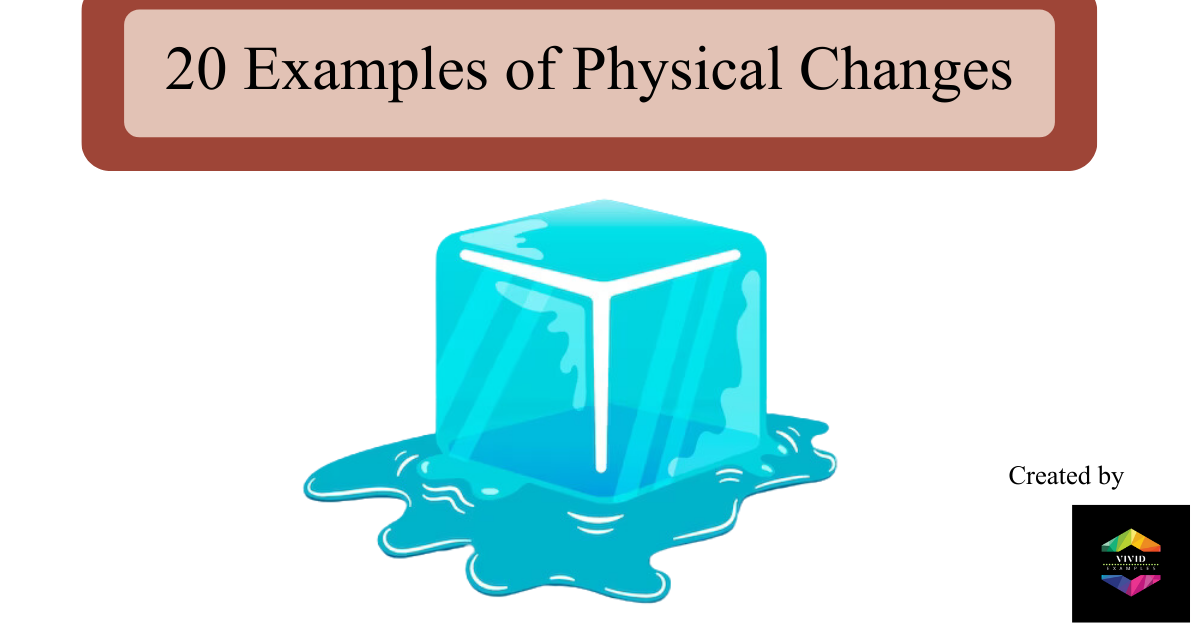Melting ice, boiling water, crushing cans, cutting papers, ripping a piece of clothes, freezing point of water, condensation on a mirror, breaking a pencil, Fog Formation, Cutting Hair, Bending a Spoon, Breaking a Glass, Mixing Salt and Pepper, Shaping Clay are some common examples of physical changes.
Physical changes, where matter transforms without altering its chemical composition, are intriguing phenomena. Explore the diverse examples below to gain insights into the dynamic nature of physical changes.
Examples of Physical Changes
Here are 20 examples of physical changes:
1. Melting Ice
When exposed to temperatures above its melting point (0 degrees Celsius), ice undergoes a physical change, transitioning from a solid to a liquid state. The molecular structure remains that of water molecules.
Experiment: Place an ice cube in a warm environment and observe as it transforms from a solid to a liquid state.
2. Boiling Water
Heating water to its boiling point (100 degrees Celsius at standard pressure) causes it to undergo a physical change, transforming from a liquid to a gaseous state (steam) without altering its chemical composition.
Experiment: Heat water in a container and observe the transition from a liquid to a gas as it reaches its boiling point.
3. Crushing a Can
The act of crushing a soda can is a physical change that modifies its shape. However, the material of the can (usually aluminum) remains the same, highlighting the nature of this transformation.
Experiment: Crush an empty soda can with your foot, noting the change in shape without altering the materials.
4. Cutting Paper
Cutting paper involves separating its fibers without changing the chemical makeup of the paper. This alteration in shape is a clear example of a physical change.
Experiment: Use scissors to cut a piece of paper, observing the alteration in shape without any chemical changes.
5. Ripping a Piece of Cloth
Ripping cloth results in a change of its appearance and structure without involving any chemical reactions. It’s a simple physical transformation.
Experiment: Tear a piece of cloth by hand, noting the change in appearance without altering the fabric's composition.
6. Freezing Point of Water
Water freezes at 0 degrees Celsius, forming ice. This physical change involves the transition from a liquid to a solid state without altering the chemical properties of water molecules.
Experiment: Place water in a freezer and observe the transformation from a liquid to a solid as it freezes.
7. Condensation on a Mirror
Condensation occurs when water vapor (gas) comes into contact with a cool surface like a mirror. The vapor undergoes a physical change, turning into liquid water droplets without any chemical alterations.
Experiment: Create condensation on a mirror by breathing on it, and witnessing the transition of water vapor from a gas to a liquid.
8. Stretching a Rubber Band
Stretching a rubber band causes a change in its shape and length without changing its chemical composition. The rubber remains fundamentally the same material.
Experiment: Stretch a rubber band and observe its altered shape without any chemical changes.
9. Breaking a Pencil
Breaking a pencil results in a physical change, altering its structure. The graphite and wood components remain the same, showcasing a change in form without a change in substance.
Experiment: Apply force to break a pencil, observing the change in structure without altering the pencil's materials.
10. Folding a Sheet of Paper
Folding paper is a physical change that alters its shape without altering its chemical composition. The fibers in the paper bend, but the material remains paper.
Experiment: Fold a sheet of paper along crease lines, noting the change in shape without any chemical alterations.11. Shaping Clay
The molding and shaping of clay represent physical changes as the clay takes on a new form without undergoing any chemical reactions. It retains its original composition.

Experiment: Mold and shape clay with your hands, observing how it transforms without changing its composition.12. Mixing Salt and Pepper
Mixing salt and pepper is a physical change, creating a heterogeneous mixture. Each component retains its individual properties, and no new substances are formed.
Experiment: Mix salt and pepper together, creating a mixture without changing the individual substances.13. Magnetizing Iron
Magnetizing iron involves rearranging its atomic structure, leading to a change in its magnetic properties. This is a physical change without altering the chemical composition of iron.
Experiment: Use a magnet to magnetize a piece of iron, observing changes in its magnetic properties without altering its composition.14. Breaking a Glass
Breaking a glass represents a physical change in its structure without changing its chemical composition. The broken pieces are still made of the same glass material.
Experiment: Break a glass and observe the change in structure without altering the glass material.15. Bending a Spoon
Bending a spoon is a physical change that alters its shape without changing the material. The spoon remains composed of the same metal.
Experiment: Apply pressure to bend a spoon, noting the change in shape without any chemical alterations.16. Cutting Hair
Cutting or trimming hair results in a physical change, changing its length and appearance without altering the composition of the hair strands.
Experiment: Use scissors to cut hair, observing the change in length and appearance without altering its chemical makeup.17. Fog Formation
The formation of fog involves the condensation of water vapor into tiny liquid droplets. This physical change occurs when the temperature drops and the vapor transitions into a visible form.
Experiment: Observe the formation of fog as water vapor undergoes a physical change, transitioning from a gas to tiny liquid droplets.18. Sublimation of Dry Ice
Dry ice (solid carbon dioxide) undergoes sublimation, transitioning directly from a solid to a gas without passing through a liquid phase. This is a physical change without altering the chemical composition of dry ice.
Experiment:Witness the sublimation of dry ice by observing its direct transition from a solid to a gas without becoming a liquid.19. Molding Chocolate
Shaping and molding chocolate represent physical changes. The melted chocolate takes on a new form without undergoing any chemical reactions.
Experiment: Shape and mold chocolate, observing its transformation without changing its ingredients.20. Wax Melting
When wax melts, it undergoes a physical change from a solid to a liquid state without changing its chemical composition. The liquid wax can later solidify upon cooling.
Experiment: Heat wax and observe its transition from a solid to a liquid state.
Physical changes are transformations that alter the appearance or state of a substance without changing its chemical composition. In this article, we will explore 20 different examples of physical changes to deepen your understanding of this scientific concept.
In the realm of science, understanding the various types of changes that matter can undergo is crucial. Physical changes represent one category of changes that occur around us daily. From the melting of ice to the breaking of glass, physical changes play a significant role in shaping our world.
Popular Examples of Physical Changes
Below is a table showcasing 20 examples of physical changes:
| Example | Description |
|---|---|
| Melting of Ice | Solid ice turns into liquid water at 0°C. |
| Boiling Water | Liquid water changes to water vapor at 100°C. |
| Freezing of Water | Liquid water turns into solid ice at 0°C. |
| Dissolving Salt | Solid salt dissolves in water, forming a solution. |
| Cutting Paper | A piece of paper is cut into smaller fragments. |
| Magnet Attraction | A magnet attracts and holds metal objects. |
| Tearing of Fabric | A piece of fabric is torn into smaller pieces. |
| Changing State of Matter | Solid, liquid, or gas states change with temperature and pressure. |
| Folding Origami | Folding paper to create various shapes and forms. |
| Grinding Coffee | Coffee beans are ground into fine coffee powder. |
| Breaking Glass | A glass object shatters into smaller pieces. |
| Condensation | Water vapor in the air turns into liquid droplets on a cold surface. |
| Sublimation | Solid substances directly convert into vapor without becoming liquid. |
| Mixing Paint Colors | Different colors of paint blend to create new shades. |
| Crushing Can | An aluminum can is crushed under pressure. |
| Evaporation | Liquid substances convert into vapor due to heat. |
| Salt Formation | Salt crystals form from a saltwater solution as it evaporates. |
| Cutting Fruits | Fruits are cut into slices or pieces for consumption. |
| Stretching Rubber Band | A rubber band elongates under force. |
| Condiment Dispersion | Sprinkling salt, pepper, or sugar over food. |
Importance of Understanding Physical Changes
Recognizing physical changes is essential in various scientific fields and everyday life. It helps us comprehend the behavior of matter under different conditions, design better products, and appreciate the transformations that shape our surroundings.
By understanding the differences between physical and chemical changes, scientists, engineers, and even students can make informed decisions in their respective disciplines.
In conclusion, physical changes are fundamental transformations that alter the appearance or state of a substance without changing its chemical composition. In this article, we explored 20 diverse examples of physical changes, ranging from phase transitions to mechanical alterations.
Remember, observing and understanding physical changes is just one step in unraveling the mysteries of the universe. Scientists continue to delve deeper into these phenomena, uncovering new insights and applications that shape the world of tomorrow. So, let’s embrace the wonders of physical changes and continue our quest for knowledge and discovery. By acknowledging and grasping these physical changes, we gain a deeper appreciation for the fascinating world of science and how it influences our daily lives.

